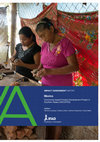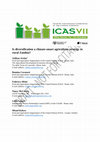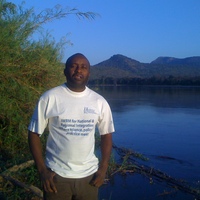Papers by Federica Alfani

IFAD Impact Assessment, 2018
The territory of Mexico is covered by forests and wildland up to about 73% of the total territor... more The territory of Mexico is covered by forests and wildland up to about 73% of the total territory (World Bank, 2015 and CONAFOR, 2012). This corresponds to around 140 million hectares, 80% of which are owned by communities and ejidos. Starting from the '80s, Mexico has experienced one of the largest deforestation rates in Latin America due to a number of complex socio-economic and political reasons which have reduced incentives to the sustainable use of forests with negative consequences for their long term conservation (Segura, 2000). To address and overcome problems linked to deforestation and forest degradation, the Community-based Forestry Development Project in Southern States (Desarrollo Comunitario Forestal en los Estados del Sur – DECOFOS) was designed and implemented from March 2011 to September 2016 with contribution from the Government of Mexico, IFAD, the Global Environment Facility (GEF) and project beneficiaries. The project had two main components. The first component was mainly meant to raise awareness of climate change and of sustainable use and management of natural resources through trainings and capacity development. This component could be instrumental to achieving impacts when combined with the second component which had a more tangible connotation. The second component, indeed, consisted on promoting sustainable management and exploitation of forest and natural resources through reforestation, adoption of agroforestry and of good environmental practices, supporting and facilitating business enterprises through the provision of technical and financial support to the start-up of micro-entrepreneurial projects and small-businesses enterprises.

Diversification of livelihoods is a strategy to stabilize incomes and consumption in the face of ... more Diversification of livelihoods is a strategy to stabilize incomes and consumption in the face of shocks. Given the fact that one of the most prominent shocks for rural households that rely on rain-fed agriculture are weather shocks, and that these are projected to get worse in most parts of the developing world, diversification plays an important role in ensuring food security under climate change. This paper contributes to the literatures on livelihood diversification, vulnerability and climate change to assess the role of diversification in a CSA agenda. Using the 2012 and 2015 waves of the nationally representative Rural Agricultural Livelihoods Survey (RALS), from Zambia together with historical rainfall data, as well as institutional data, we analyze the determinants of diversification, income and probability of poverty using panel data methodologies. Results show that income diversification is driven by negative shocks and acts as a coping strategy, whereas livestock diversification is driven by pull factors. The effects of different types of
diversification on the level of income and the probability of poverty. Policy implications are identified to support livelihood diversification and food security under the realities of climate change. This paper contributes to a better understanding of the linkages between climate shocks, diversification and welfare outcomes with a goal to highlight potential policy entry points to incentivize the types of diversification that help households to improve food security and become resilient to climate shocks.
Confronting Drought in Africa's Drylands: Opportunities for Enhancing Resilience, 2016
Confronting Drought in Africa's Drylands: Opportunities for Enhancing Resilience, 2016
SSRN Electronic Journal, 2000
Policy Research Working Papers, 2015
Policy Research Working Papers, 2015

Policy Research Working Papers, 2012
ABSTRACT This paper has three primary objectives: (i) to investigate potential problems regarding... more ABSTRACT This paper has three primary objectives: (i) to investigate potential problems regarding Mozambique's most recent nationally representative household survey on poverty dynamics; (ii) to assess the robustness and reliability of official poverty statistics; and (iii) to provide alternative estimates of poverty and welfare indicators in light of the methodological and analytical issues raised in areas (i) and (ii). It is determined that at least two significant weaknesses affect the official poverty-rate estimates: measurement errors in consumption data and flaws in the methodology used to calculate poverty lines (the cost-of-basic-needs approach based on provincial food bundles with entropy correction). A number of observations appear to be affected by substantial measurement errors, which severely distort the official poverty statistics. The paper provides methods to correct the consumption distribution by recalculating poverty lines based on a single national food basket -- as opposed to the current estimates, which are based on province-specific food baskets. The revised poverty statistics differ considerably from the official estimates of poverty across provinces and are far more consistent with other poverty indicators. In addition, poverty appears to be highly concentrated in certain areas, with dramatically higher rates found in Central and Northern Mozambique, as well as in rural areas overall, compared with relatively low rates in Southern Mozambique and in the country's urban centers. These findings substantially contradict the government's official poverty figures, which appear to systematically overestimate poverty rates in Mozambique's Southern provinces and urban areas while simultaneously underestimating the prevalence of poverty in the country's Central and Northern regions and in rural areas nationwide.









Uploads
Papers by Federica Alfani
diversification on the level of income and the probability of poverty. Policy implications are identified to support livelihood diversification and food security under the realities of climate change. This paper contributes to a better understanding of the linkages between climate shocks, diversification and welfare outcomes with a goal to highlight potential policy entry points to incentivize the types of diversification that help households to improve food security and become resilient to climate shocks.
diversification on the level of income and the probability of poverty. Policy implications are identified to support livelihood diversification and food security under the realities of climate change. This paper contributes to a better understanding of the linkages between climate shocks, diversification and welfare outcomes with a goal to highlight potential policy entry points to incentivize the types of diversification that help households to improve food security and become resilient to climate shocks.